hood open HONDA ODYSSEY 2015 RC1-RC2 / 5.G Quick Guide
[x] Cancel search | Manufacturer: HONDA, Model Year: 2015, Model line: ODYSSEY, Model: HONDA ODYSSEY 2015 RC1-RC2 / 5.GPages: 80, PDF Size: 10.54 MB
Page 9 of 80
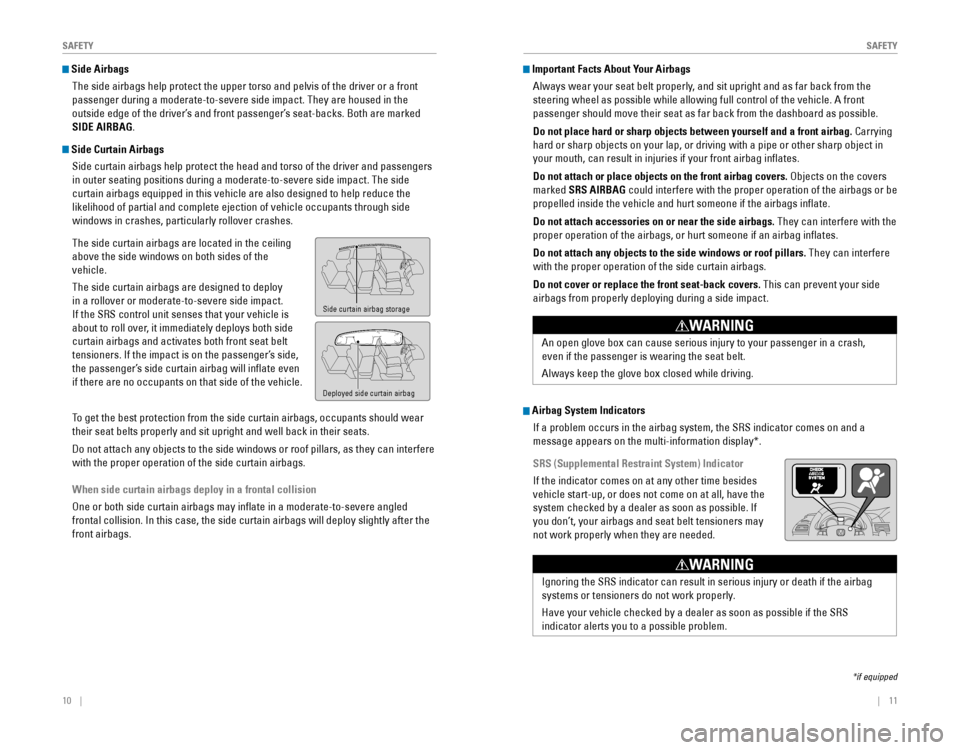
10 || 11
SAFETYSAFETY
Side Airbags
The side airbags help protect the upper torso and pelvis of the driver or a front
passenger during a moderate-to-severe side impact. They are housed in th\
e
outside edge of the driver’s and front passenger’s seat-backs. Both are marked
SIDE AIRBAG.
Side Curtain Airbags
Side curtain airbags help protect the head and torso of the driver and passengers
in outer seating positions during a moderate-to-severe side impact. The \
side
curtain airbags equipped in this vehicle are also designed to help reduce the
likelihood of partial and complete ejection of vehicle occupants through\
side
windows in crashes, particularly rollover crashes.
The side curtain airbags are located in the ceiling
above the side windows on both sides of the
vehicle.
The side curtain airbags are designed to deploy
in a rollover or moderate-to-severe side impact.
If the SRS control unit senses that your vehicle is
about to roll over, it immediately deploys both side
curtain airbags and activates both front seat belt
tensioners. If the impact is on the passenger’s side,
the passenger’s side curtain airbag will inflate even
if there are no occupants on that side of the vehicle.
To get the best protection from the side curtain airbags, occupants should wear
their seat belts properly and sit upright and well back in their seats.
Do not attach any objects to the side windows or roof pillars, as they can interfere
with the proper operation of the side curtain airbags.
When side curtain airbags deploy in a frontal collision
One or both side curtain airbags may inflate in a moderate-to-severe angled
frontal collision. In this case, the side curtain airbags will deploy slightly after the
front airbags.
Side curtain airbag storage
Deployed side curtain airbag
Important Facts About Your Airbags
Always wear your seat belt properly, and sit upright and as far back from the
steering wheel as possible while allowing full control of the vehicle. A front
passenger should move their seat as far back from the dashboard as possible.
Do not place hard or sharp objects between yourself and a front airbag. Carrying
hard or sharp objects on your lap, or driving with a pipe or other sharp object in
your mouth, can result in injuries if your front airbag inflates.
Do not attach or place objects on the front airbag covers. Objects on the covers
marked SRS AIRBAG could interfere with the proper operation of the airbags or be
propelled inside the vehicle and hurt someone if the airbags inflate.
Do not attach accessories on or near the side airbags. They can interfere with the
proper operation of the airbags, or hurt someone if an airbag inflates.
Do not attach any objects to the side windows or roof pillars. They can interfere
with the proper operation of the side curtain airbags.
Do not cover or replace the front seat-back covers. This can prevent your side
airbags from properly deploying during a side impact.
An open glove box can cause serious injury to your passenger in a crash,
even if the passenger is wearing the seat belt.
Always
keep the glove box closed while driving.
WARNING
Airbag System Indicators
If a problem occurs in the airbag system, the SRS indicator comes on and a
message appears on the multi-information display*.
SRS (Supplemental Restraint System) Indicator
If the indicator comes on at any other time besides
vehicle start-up, or does not come on at all, have the
system checked by a dealer as soon as possible. If
you don’t, your airbags and seat belt tensioners may
not work properly when they are needed.
Ignoring the SRS indicator can result in serious injury or death if the airbag
systems or tensioners do not work properly.
Have
your vehicle checked by a dealer as soon as possible if the SRS
indicator alerts you to a possible problem.
WARNING
*
*if equipped
Page 16 of 80
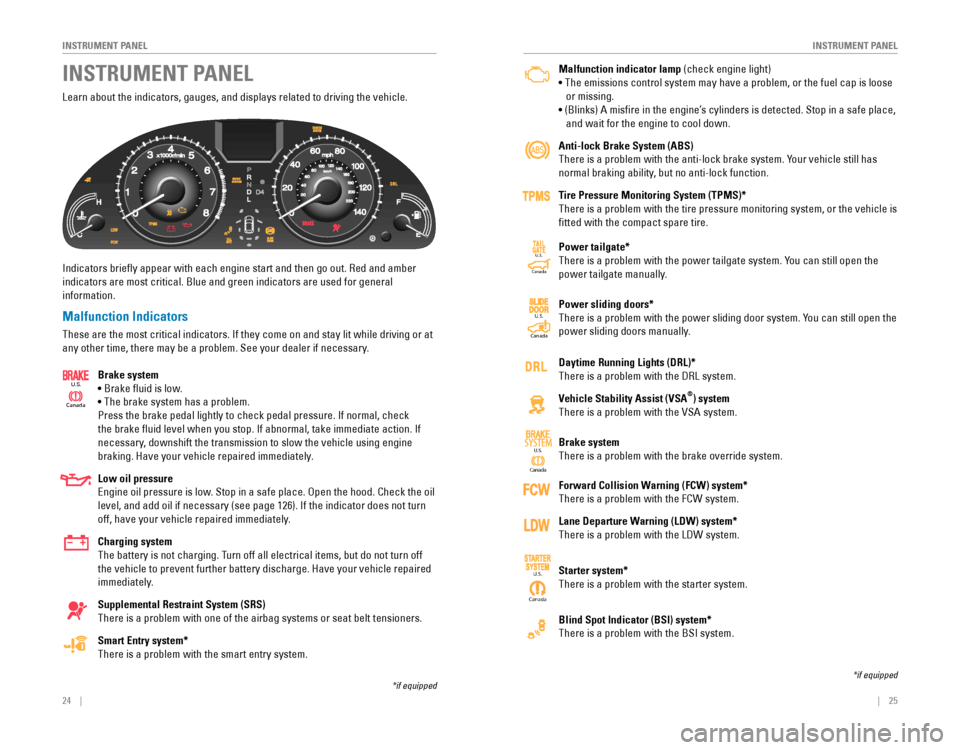
24 || 25
INSTRUMENT PANELINSTRUMENT PANEL
Learn about the indicators, gauges, and displays related to driving the vehicle.
Indicators briefly appear with each engine start and then go out. Red and amber
indicators are most critical. Blue and green indicators are used for gen\
eral
information.
Malfunction Indicators
These are the most critical indicators. If they come on and stay lit while driving or at
any other time, there may be a problem. See your dealer if necessary.
Brake system
• Brake fluid is low.
• The brake system has a problem.
Press the brake pedal lightly to check pedal pressure. If normal, check
the brake fluid level when you stop. If abnormal, take immediate action. If
necessary, downshift the transmission to slow the vehicle using engine
braking. Have your vehicle repaired immediately.
Low oil pressure
Engine oil pressure is low. Stop in a safe place. Open the hood. Check the oil
level, and add oil if necessary (see page 126). If the indicator does not turn
off, have your vehicle repaired immediately.
Charging system
The battery is not charging. Turn off all electrical items, but do not turn off
the vehicle to prevent further battery discharge. Have your vehicle repaired
immediately.
Supplemental Restraint System (SRS)
There is a problem with one of the airbag systems or seat belt tensioners.
Smart Entry system*
There is a problem with the smart entry system.
INSTRUMENT PANEL
Canada
U.S.
*if equipped
Malfunction indicator lamp (check engine light)
• The emissions control system may have a problem, or the fuel cap is loose
or missing.
• (Blinks) A misfire in the engine’s cylinders is detected. Stop in a safe place,
and wait for the engine to cool down.
Anti-lock Brake System (ABS)
There is a problem with the anti-lock brake system. Your vehicle still has
normal braking ability, but no anti-lock function.
Tire Pressure Monitoring System (TPMS)*
There is a problem with the tire pressure monitoring system, or the vehicle is
fitted with the compact spare tire.
Power tailgate*
There is a problem with the power tailgate system. You can still open the
power tailgate manually.
Power sliding doors*
There is a problem with the power sliding door system. You can still open the
power sliding doors manually.
Daytime Running Lights (DRL)*
There is a problem with the DRL system.
Vehicle Stability Assist (VSA®) system
There is a problem with the VSA system.
Brake system
There is a problem with the brake override system.
Forward Collision Warning (FCW) system*
There is a problem with the FCW system.
Lane Departure Warning (LDW) system*
There is a problem with the LDW system.
Starter system*
There is a problem with the starter system.
Blind Spot Indicator (BSI) system*
There is a problem with the BSI system.
Ca nada
U.S.SYSTEM
CanadaU.S.
Canada
U.S.
CanadaU.S.
*if equipped
Page 29 of 80
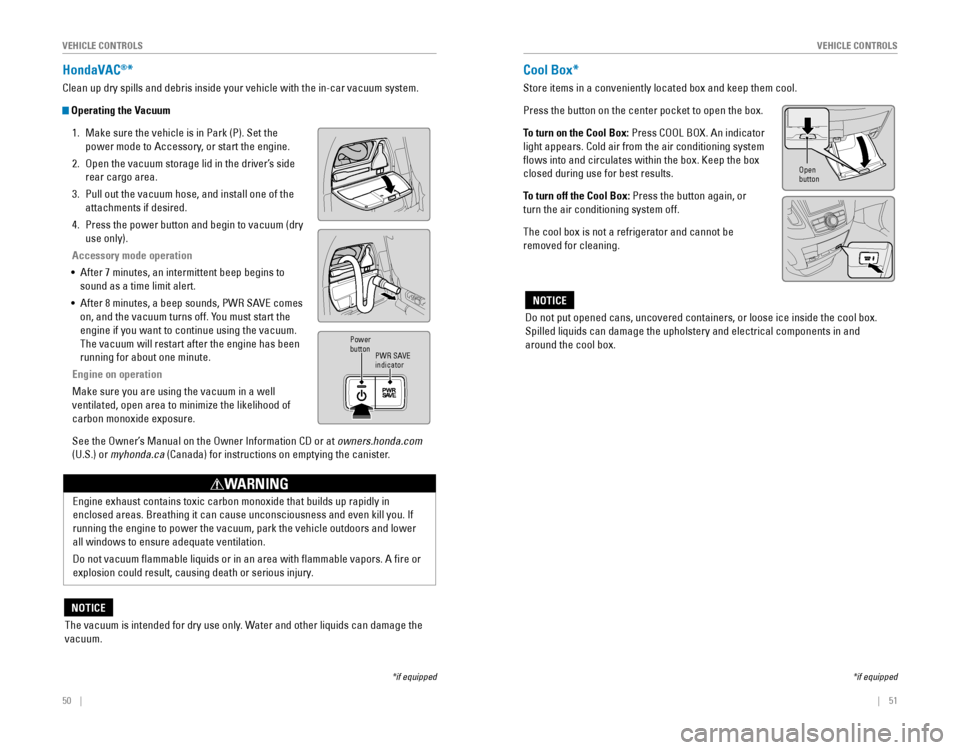
50 || 51
VEHICLE CONTROLSVEHICLE CONTROLS
HondaVAC®*
Clean up dry spills and debris inside your vehicle with the in-car vacuum system.
Operating the Vacuum
1. Make sure the vehicle is in Park (P). Set the
power mode to Accessory, or start the engine.
2. Open the vacuum storage lid in the driver’s side
rear cargo area.
3. Pull out the vacuum hose, and install one of the
attachments if desired.
4. Press the power button and begin to vacuum (dry
use only).
Accessory mode operation
•
After 7 minutes, an intermittent beep begins to
sound as a time limit alert.
•
After 8 minutes, a beep sounds, PWR SAVE comes
on, and the vacuum turns off. You must start the
engine if you want to continue using the vacuum.
The vacuum will restart after the engine has been
running for about one minute.
Engine on operation
Make sure you are using the vacuum in a well
ventilated, open area to minimize the likelihood of
carbon monoxide exposure.
See the Owner’s Manual on the Owner Information CD or at owners.honda.com
(U.S.) or myhonda.ca (Canada) for instructions on emptying the canister.
PWR SAVEindicator
Power
button
Engine exhaust contains toxic carbon monoxide that builds up rapidly in
enclosed areas. Breathing it can cause unconsciousness and even kill you. If
running the engine to power the vacuum, park the vehicle outdoors and lo\
wer
all windows to ensure adequate ventilation.
Do not vacuum flammable liquids or in an area with flammable vapors. A fire or
explosion could result, causing death or serious injury.
WARNING
The vacuum is intended for dry use only. Water and other liquids can damage the
vacuum.
NOTICE
*if equipped
Cool Box*
Store items in a conveniently located box and keep them cool.
Press the button on the center pocket to open the box.
To turn on the Cool Box:
Press COOL BOX. An indicator
light appears. Cold air from the air conditioning system
flows into and circulates within the box. Keep the box
closed during use for best results.
To turn off the Cool Box: Press the button again, or
turn the air conditioning system off.
The cool box is not a refrigerator and cannot be
removed for cleaning.
Do not put opened cans, uncovered containers, or loose ice inside the cool box.
Spilled liquids can damage the upholstery and electrical components in and
around the cool box.
NOTICE
*if equipped
Open
button
Page 49 of 80
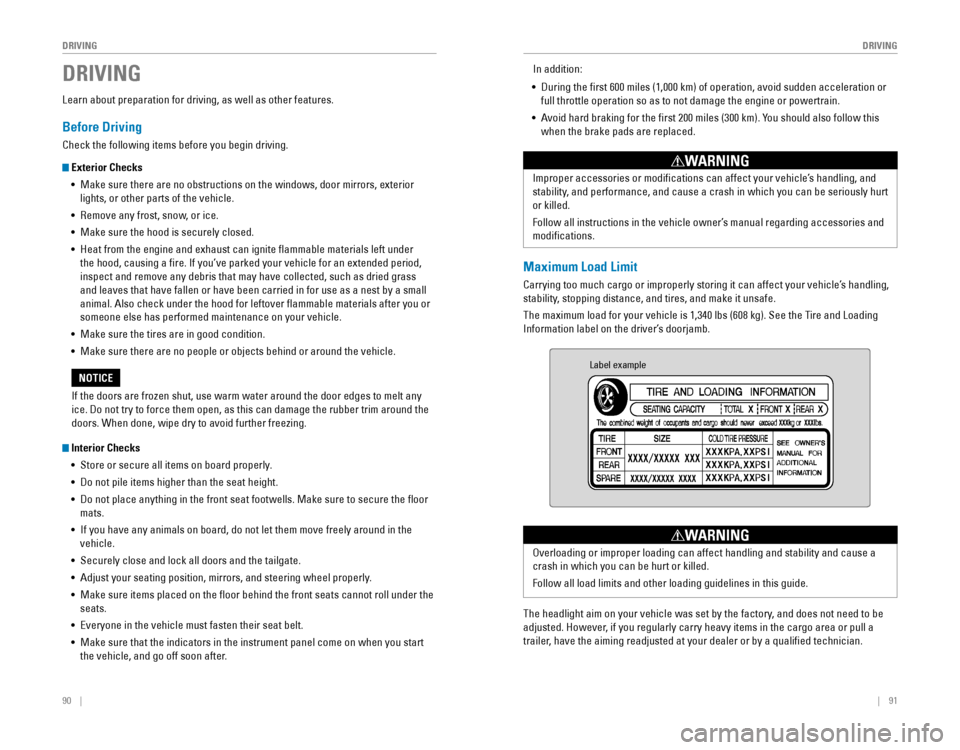
90 || 91
DRIVING
DRIVING
Learn about preparation for driving, as well as other features.
Before Driving
Check the following items before you begin driving.
Exterior Checks
•
Make sure there are no obstructions on the windows, door mirrors, exterior
lights, or other parts of the vehicle.
• Remove any frost, snow, or ice.
• Make sure the hood is securely closed.
•
Heat from the engine and exhaust can ignite flammable materials left under
the hood, causing a fire. If you’ve parked your vehicle for an extended period,
inspect and remove any debris that may have collected, such as dried grass
and leaves that have fallen or have been carried in for use as a nest by a small
animal. Also check under the hood for leftover flammable materials after you or
someone else has performed maintenance on your vehicle.
• Make sure the tires are in good condition.
•
Make sure there are no people or objects behind or around the vehicle.
Interior Checks •
Store or secure all items on board properly.
• Do not pile items higher than the seat height.
• Do not place anything in the front seat footwells. Make sure to secure the floor
mats.
•
If you have any animals on board, do not let them move freely around in the
vehicle.
• Securely close and lock all doors and the tailgate.
• Adjust your seating position, mirrors, and steering wheel properly.
•
Make sure items placed on the floor behind the front seats cannot roll under the
seats.
•
Everyone in the vehicle must fasten their seat belt.
• Make sure that the indicators in the instrument panel come on when you s\
tart
the vehicle, and go off soon after.
DRIVING
If the doors are frozen shut, use warm water around the door edges to melt any
ice. Do not try to force them open, as this can damage the rubber trim around the
doors. When done, wipe dry to avoid further freezing.
NOTICE
Maximum Load Limit
Carrying too much cargo or improperly storing it can affect your vehicle\
’s handling,
stability, stopping distance, and tires, and make it unsafe.
The maximum load for your vehicle is 1,340 lbs (608 kg). See the Tire and Loading
Information label on the driver’s doorjamb.
Improper accessories or modifications can affect your vehicle’s handling, and
stability, and performance, and cause a crash in which you can be seriously hurt
or killed.
Follow all instructions in the vehicle owner’s manual regarding accessories and
modifications.
WARNING
In addition:
• During the first 600 miles (1,000 km) of operation, avoid sudden acceleration or
full throttle operation so as to not damage the engine or powertrain.
•
Avoid hard braking for the first 200 miles (300 km). You should also follow this
when the brake pads are replaced.
Label example
The headlight aim on your vehicle was set by the factory, and does not need to be
adjusted. However, if you regularly carry heavy items in the cargo area or pull a
trailer, have the aiming readjusted at your dealer or by a qualified technician.
Overloading or improper loading can affect handling and stability and cause a
crash in which you can be hurt or killed.
Follow all load limits and other loading guidelines in this guide.
WARNING
Page 57 of 80
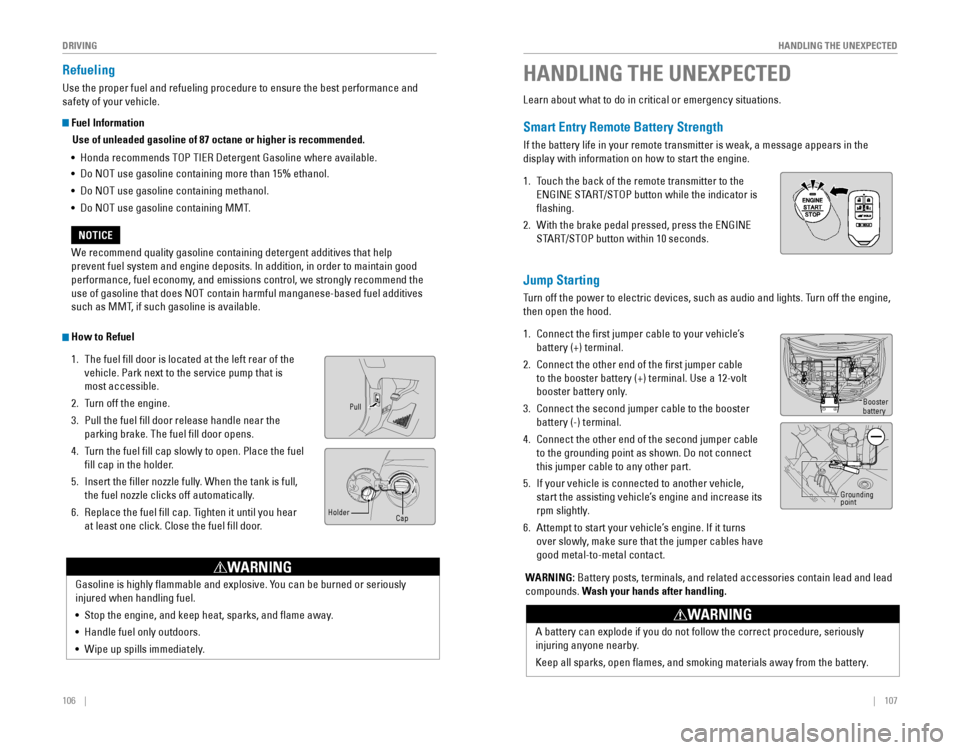
106 || 107
HANDLING THE UNEXPECTED
DRIVING
Refueling
Use the proper fuel and refueling procedure to ensure the best performance and
safety of your vehicle.
Fuel Information
Use of unleaded gasoline of 87 octane or higher is recommended.
•
Honda recommends TOP TIER Detergent Gasoline where available.
• Do NOT use gasoline containing more than 15% ethanol.
• Do NOT use gasoline containing methanol.
• Do NOT use gasoline containing MMT.
We recommend quality gasoline containing detergent additives that help
prevent fuel system and engine deposits. In addition, in order to maintain good
performance, fuel economy, and emissions control, we strongly recommend the
use of gasoline that does NOT contain harmful manganese-based fuel additives
such as MMT, if such gasoline is available.
NOTICE
How to Refuel
1. The fuel fill door is located at the left rear of the
vehicle. Park next to the service pump that is
most accessible.
2. Turn off the engine.
3. Pull the fuel fill door release handle near the
parking brake. The fuel fill door opens.
4. Turn the fuel fill cap slowly to open. Place the fuel
fill cap in the holder.
5. Insert the filler nozzle fully. When the tank is full,
the fuel nozzle clicks off automatically.
6. Replace the fuel fill cap. Tighten it until you hear
at least one click. Close the fuel fill door.
Pull
Cap
Holder
Gasoline is highly flammable and explosive. You can be burned or seriously
injured when handling fuel.
•
Stop the engine, and keep heat, sparks, and flame away.
• Handle fuel only outdoors.
• Wipe up spills immediately.
WARNING
Learn about what to do in critical or emergency situations.
Smart Entry Remote Battery Strength
If the battery life in your remote transmitter is weak, a message appears in the
display with information on how to start the engine.
1. Touch the back of the remote transmitter to the
ENGINE START/STOP button while the indicator is
flashing.
2. With the brake pedal pressed, press the ENGINE
START/STOP button within 10 seconds.
Jump Starting
Turn off the power to electric devices, such as audio and lights. Turn off the engine,
then open the hood.
1. Connect the first jumper cable to your vehicle’s
battery (+) terminal.
2. Connect the other end of the first jumper cable
to the booster battery (+) terminal. Use a 12-volt
booster battery only.
3. Connect the second jumper cable to the booster
battery (-) terminal.
4. Connect the other end of the second jumper cable
to the grounding point as shown. Do not connect
this jumper cable to any other part.
5. If your vehicle is connected to another vehicle,
start the assisting vehicle’s engine and increase its
rpm slightly.
6. Attempt to start your vehicle’s engine. If it turns
over slowly, make sure that the jumper cables have
good metal-to-metal contact.
HANDLING THE UNEXPECTED
Booster
battery
WARNING: Battery posts, terminals, and related accessories contain lead and lead\
compounds. Wash your hands after handling.
A battery can explode if you do not follow the correct procedure, seriously
injuring anyone nearby.
Keep all sparks, open flames, and smoking materials away from the battery.
WARNING
Grounding
point
Page 58 of 80
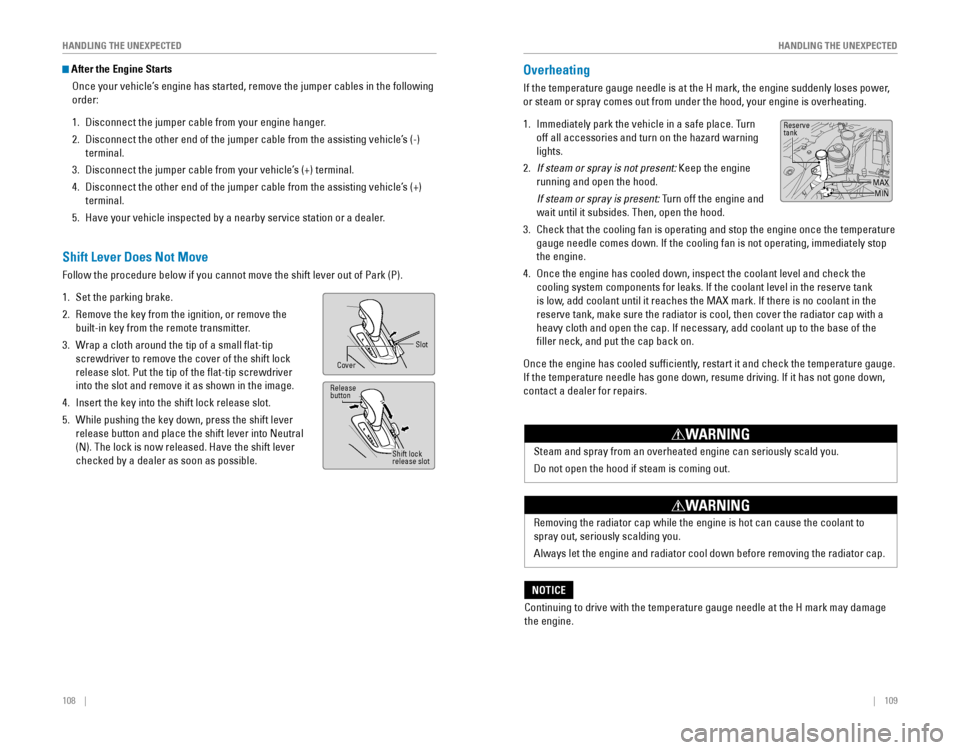
108 || 109
HANDLING THE UNEXPECTED
HANDLING THE UNEXPECTED
Shift Lever Does Not Move
Follow the procedure below if you cannot move the shift lever out of Park (P).
1. Set the parking brake.
2. Remove the key from the ignition, or remove the
built-in key from the remote transmitter.
3. Wrap a cloth around the tip of a small flat-tip
screwdriver to remove the cover of the shift lock
release slot. Put the tip of the flat-tip screwdriver
into the slot and remove it as shown in the image.
4. Insert the key into the shift lock release slot.
5. While pushing the key down, press the shift lever
release button and place the shift lever into Neutral
(N). The lock is now released. Have the shift lever
checked by a dealer as soon as possible.
After the Engine Starts
Once your vehicle’s engine has started, remove the jumper cables in the following
order:
1. Disconnect the jumper cable from your engine hanger.
2. Disconnect the other end of the jumper cable from the assisting vehicle’s (-)
terminal.
3. Disconnect the jumper cable from your vehicle’s (+) terminal.
4. Disconnect the other end of the jumper cable from the assisting vehicle’s (+)
terminal.
5. Have your vehicle inspected by a nearby service station or a dealer.
Slot
Cover
Release
button
Shift lock
release slot
Overheating
If the temperature gauge needle is at the H mark, the engine suddenly loses power,
or steam or spray comes out from under the hood, your engine is overheat\
ing.
1. Immediately park the vehicle in a safe place. Turn
off all accessories and turn on the hazard warning
lights.
2. If steam or spray is not present: Keep the engine
running and open the hood.
If steam or spray is present: Turn off the engine and
wait until it subsides. Then, open the hood.
3. Check that the cooling fan is operating and stop the engine once the tem\
perature
gauge needle comes down. If the cooling fan is not operating, immediately stop
the engine.
4. Once the engine has cooled down, inspect the coolant level and check the\
cooling system components for leaks. If the coolant level in the reserve tank
is low, add coolant until it reaches the MAX mark. If there is no coolant in the
reserve tank, make sure the radiator is cool, then cover the radiator ca\
p with a
heavy cloth and open the cap. If necessary, add coolant up to the base of the
filler neck, and put the cap back on.
Once the engine has cooled sufficiently, restart it and check the temperature gauge.
If the temperature needle has gone down, resume driving. If it has not gone down,
contact a dealer for repairs.
Steam and spray from an overheated engine can seriously scald you.
Do not open the hood if steam is coming out.
Removing the radiator cap while the engine is hot can cause the coolant \
to
spray out, seriously scalding you.
Always let the engine and radiator cool down before removing the radiator cap.
WARNING
WARNING
Continuing to drive with the temperature gauge needle at the H mark may \
damage
the engine.
NOTICE
Reserve
tank
MAXMIN
Page 61 of 80
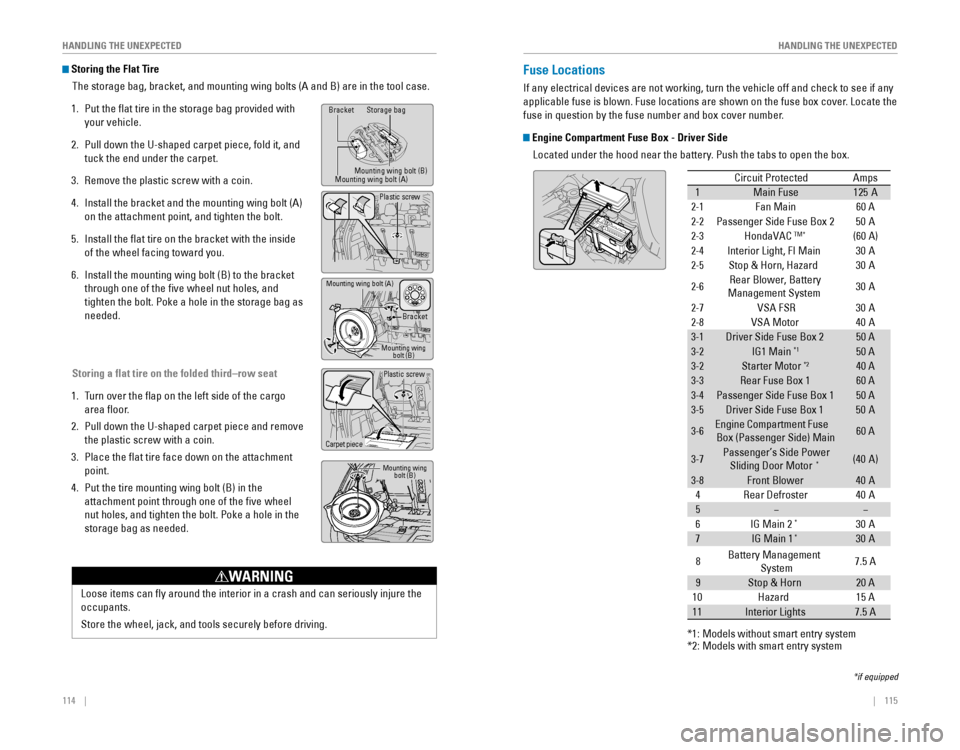
114 || 115
HANDLING THE UNEXPECTED
HANDLING THE UNEXPECTED
Storing the Flat Tire
The storage bag, bracket, and mounting wing bolts (A and B) are in the tool case.
1. Put the flat tire in the storage bag provided with
your vehicle.
2. Pull down the U-shaped carpet piece, fold it, and
tuck the end under the carpet.
3. Remove the plastic screw with a coin.
4. Install the bracket and the mounting wing bolt (A)
on the attachment point, and tighten the bolt.
5. Install the flat tire on the bracket with the inside
of the wheel facing toward you.
6. Install the mounting wing bolt (B) to the bracket
through one of the five wheel nut holes, and
tighten the bolt. Poke a hole in the storage bag as
needed.
Storing a flat tire on the folded third–row seat
1. Turn over the flap on the left side of the cargo
area floor.
2. Pull down the U-shaped carpet piece and remove
the plastic screw with a coin.
3. Place the flat tire face down on the attachment
point.
4. Put the tire mounting wing bolt (B) in the
attachment point through one of the five wheel
nut holes, and tighten the bolt. Poke a hole in the
storage bag as needed.
Loose items can fly around the interior in a crash and can seriously i\
njure the
occupants.
Store the wheel, jack, and tools securely before driving.
WARNING
Bracket
Bracket
Plastic screw
Carpet pieceStorage bag
Mounting wing bolt (B)
Mounting wing bolt (B)
Mounting wing bolt (B)
Mounting wing bolt (A)
Mounting wing bolt (A)
Plastic screw
Fuse Locations
If any electrical devices are not working, turn the vehicle off and check to see if any
applicable fuse is blown. Fuse locations are shown on the fuse box cover. Locate the
fuse in question by the fuse number and box cover number.
Engine Compartment Fuse Box - Driver Side
Located under the hood near the battery. Push the tabs to open the box.
Circuit ProtectedAmps
1Main Fuse12 5A
2-1Fan Main 60 A
2-2Passenger Side Fuse Box 2
2-3HondaVACTM*(60 A)
2-4Interior Light, FI Main
2-5Stop & Horn, Hazard
2-6Rear Blower, Battery
Ma nagement System 30
A
30
A
30
A
2-7VSA FSR 30A
50
A
2-8VSA Moto r
3-1Driver Side Fuse Box 250 A
3-2IG1 Main*150 A
3-2Starter Motor*240 A
3-3Rear Fuse Box 160 A
3-4Passenger Side Fuse Box 150 A
3-5Driver Side Fuse Box 150 A
3-6Engine Compartment Fuse
Box (Passenger Side) Main60 A
3-7Passenger’s Side Power
Sliding Door Moto r*(40A )
3-8Front Blower40A
40 A
40
A
4Rear Defroster
5��
6I G Main 2*30A
7IG Main 1*30A
*1: M odels without smart entry system*2: M odels with smart entry system
8 Battery Management
System 7.5
A
9Stop & Hor n20 A
15 A
10 Hazard
11Interior Lights7.5 A
*if equipped
Page 62 of 80

116 || 117
HANDLING THE UNEXPECTED
HANDLING THE UNEXPECTED
Engine Compartment Fuse Box - Passenger Side
Located under the hood near the windshield washer reservoir. Push the tabs to
open the box.
Circuit Protecte dAmps
1��
2� �
3ACG FR15A
4W ashe
r15 A
5VB SOL7.5 A
6E CU FR 7.5 A
7��
8F I Su
b15A
9DBW15A
10 FI Main 15 A
11Ignition Coil15 A
12��
13��
14��
15Radio20 A
16 Back Up 10A
17MG Clutch7.5A
18 Front Fog Lights*(20 A)
19��
20 Right Headlight High Beam 10A
21��
22 Small Lights 10 A
23��
24 Left Headlight High Beam 10 A
25��
26 Right Headlight Low Beam 15 A
27Left Headlight Low Beam15 A
28 Oil Level 7.5 A
29Main Fa n30A
30 Sub Fan 30A
31Wiper Main30 A
*if equipped
Interior Fuse Box - Driver Side
Located under the dashboard.
Circuit Protecte dAmps
1Front Passenger's Door
Lock7.5 A
2Rear Passenger's Door Lock7.5A
3Driver’s Door Lock7.5A
4Front Passenger's Door
Unlock7.5A
5Rear Passenger's Door
Unlock7.5A
6Driver’s Door Unlock7.5A
7Door Lock Main20 A
8HAC Option*10 A
9Driver’s Side Power Sliding
Door Closer*(20A )
10 Rear Fuse Bo
x15 A
11Meter7.5 A
12 Engine Compartment
Fuse
Box (Passenger Side) 20
A
13Accessor y7.5A
14 STS*7.5 A
15Driver’s Power Seat Sliding20A
16 Moonroof*(20 A)
17Rear Driver’s Side Power Window20 A
18 Smart Entry System
*(10 A)
19Driver’s Power Window20 A
20
��
21Fuel Pump20 A
22 Passenger Side Fuse Bo x15 A
23VSA7.5A
24 ACG AS 7.5 A
25STRLD7.5A
26 HAC 7.5 A
27DRL(7.5 A)
28 ACC Key Lock 7.5A
29Driver’s Power Seat Lumbar
Suppor t*(7.5 A)
30 TPMS 7.5A
31��
32 Driver’s Power Seat
Reclining 20
A
33Driver’s Side Power Sliding
Door Moto r*(40A )
34
��
Fuse label
*if equipped
Page 66 of 80

124 || 125
MAINTENANCE
MAINTENANCE
Under the Hood
Opening the Hood
1. Park the vehicle on a level surface, and set the
parking brake.
2. Pull the hood release handle under the lower left
corner of the dashboard.
3. Push up the hood latch lever in the center of the
hood to release the lock mechanism, and open
the hood.
4. Remove the support rod from the clamp using the
grip. Mount the support rod in the hood.
When closing, remove the support rod, and
stow it in the clamp, then gently lower the hood.
Remove your hand at a height of approximately
12 inches (30 cm) and let the hood close.
Do not open the hood when the wiper arms are raised. The hood will strike the
wipers, and may damage either the hood or the wipers.
NOTICE
Power steering fluid
(red cap) Brake fluid
(black cap)
Battery
Engine oil fill cap
Hood release handle
Lever
Support rod
Grip
Clamp
Pull
Washer fluid
(blue cap)
Engine coolant
reservoir
Engine oil dipstick
(orange loop)
Radiator cap
Recommended Engine Oil
•
Honda Genuine Motor Oil
• Premium-grade 0W-20 detergent oil with an API Certification Seal on the
container
This seal indicates the oil is energy conserving and
that it meets the American Petroleum Institute’s
latest requirements.
Use Honda Genuine Motor Oil or another
commercial engine oil of suitable viscosity for the
ambient temperature as shown.
You may also use synthetic motor oil if it is labeled with the API Certification Seal
and is of the specified viscosity grade.
Engine Oil
Park the vehicle on level ground, and wait approximately three minutes after turning
the engine off before you check the oil.
Checking the Oil
1. Remove the dipstick (orange loop).
2. Wipe the dipstick with a clean cloth or paper
towel.
3. Insert the dipstick back all the way into its hole.
4. Remove the dipstick again, and check the level.
It should be between the upper and lower marks.
Add oil if necessary.Upper markLower mark
Ambient temperature
Page 79 of 80
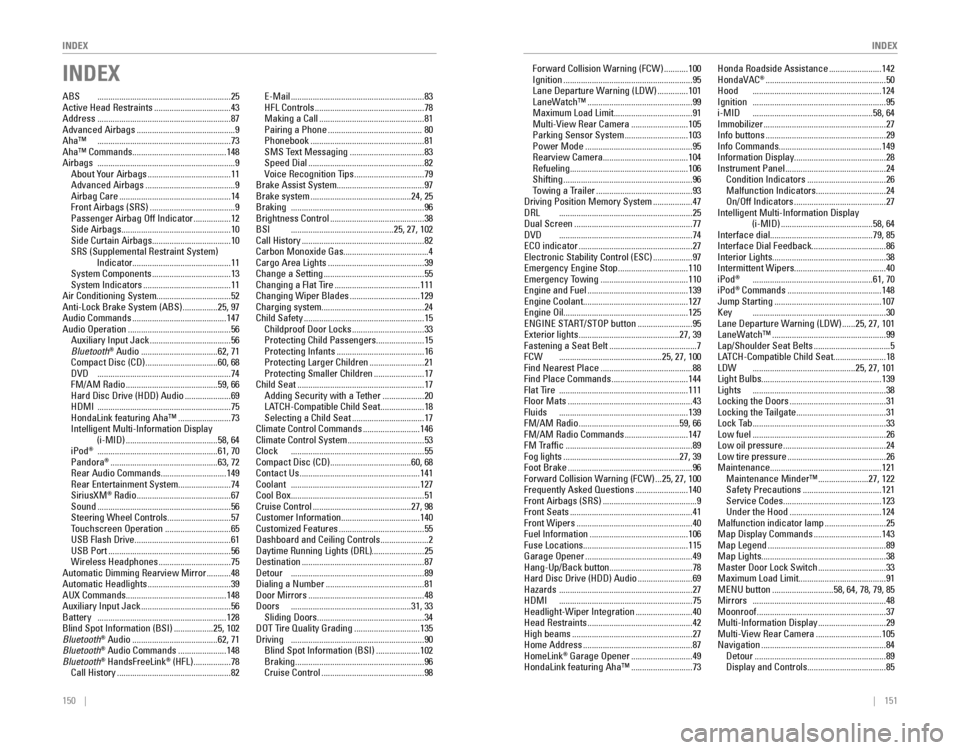
150 || 151
INDEX
INDEX
INDEX
ABS .............................................................25
Active Head Restraints ...................................43Address .............................................................87Advanced Airbags .............................................9Aha™ .............................................................73Aha™ Commands ...........................................148Airbags ...............................................................9About Your Airbags ......................................11Advanced Airbags .........................................9Airbag Care ...................................................14Front Airbags (SRS) .......................................9Passenger Airbag Off Indicator .................12Side Airbags ..................................................10Side Curtain Airbags ....................................10
SRS (Supplemental Restraint System) Indicator ............................................. 11
System Components
....................................13System Indicators ........................................11
Air Conditioning System ..................................52
Anti-Lock Brake System (ABS)
................25, 97
Audio Commands ...........................................147
Audio Operation ...............................................56Auxiliary Input Jack .....................................56
Bluetooth® Audio ...................................62, 71Compact Disc (CD) .................................60, 68DVD .............................................................74FM/AM Radio ..........................................59, 66Hard Disc Drive (HDD) Audio .....................69HDMI .............................................................75HondaLink featuring Aha™ ........................73Intelligent Multi-Information Display
(i-MID) ..........................................58, 64iPod® .......................................................61, 70Pandora® .................................................63, 72Rear Audio Commands ..............................149Rear Entertainment System ........................74
SiriusXM® Radio ...........................................67Sound .............................................................56
Steering Wheel Controls .............................57
Touchscreen Operation ..............................65USB Flash Drive ............................................61
USB Port ........................................................56
Wireless Headphones .................................75Automatic Dimming Rearview Mirror ...........48
Automatic Headlights ......................................39
AUX Commands .............................................. 148
Auxiliary Input Jack .........................................56Battery ...........................................................128Blind Spot Information (BSI) ..................25, 102
Bluetooth® Audio .......................................62, 71Bluetooth® Audio Commands ......................148
Bluetooth® HandsFreeLink® (HFL) .................78
Call History ....................................................82
E-Mail .............................................................83
HFL Controls ..................................................78
Making a Call ................................................81
Pairing a Phone ........................................... 80
Phonebook ....................................................81
SMS Text Messaging ..................................83Speed Dial .....................................................82
Voice Recognition Tips ................................79
Brake Assist System ........................................ 97
Brake system
..............................................24, 25Braking .............................................................96
Brightness Control ...........................................38BSI ...............................................25, 27, 102
Call History ........................................................82Carbon Monoxide Gas....................................... 4
Cargo Area Lights ............................................39
Change a Setting ..............................................55
Changing a Flat Tire .......................................111
Changing Wiper Blades ................................129
Charging system ............................................... 24
Child Safety
.......................................................15Childproof Door Locks .................................33
Protecting Child Passengers ......................15Protecting Infants ........................................16
Protecting Larger Children .........................21
Protecting Smaller Children .......................17
Child Seat ..........................................................17
Adding Security with a Tether ...................20LATCH-Compatible Child Seat ....................18
Selecting a Child Seat .................................17
Climate Control Commands ..........................146
Climate Control System ...................................53Clock .............................................................55Compact Disc (CD) .....................................60, 68Contact Us .......................................................141Coolant ...........................................................127
Cool Box ............................................................. 51
Cruise Control
.............................................27, 98Customer Information.................................... 140Customized Features .......................................55Dashboard and Ceiling Controls ......................2Daytime Running Lights (DRL)........................25
Destination ........................................................87Detour .............................................................89Dialing a Number .............................................81Door Mirrors .....................................................48Doors .......................................................31, 33Sliding Doors .................................................34DOT Tire Quality Grading ..............................135Driving .............................................................90Blind Spot Information (BSI) ....................102
Braking ...........................................................96
Cruise Control ...............................................98 Forward Collision Warning (FCW)
...........100
Ignition ...........................................................95Lane Departure Warning (LDW) ..............101
LaneWatch™ ................................................99
Maximum Load Limit ....................................91
Multi-View Rear Camera ..........................105
Parking Sensor System .............................103
Power Mode .................................................95
Rearview Camera .......................................104
Refueling ......................................................106
Shifting ...........................................................96
Towing a Trailer ............................................93Driving Position Memory System ..................47DRL .............................................................25Dual Screen ......................................................77DVD .............................................................74ECO indicator ....................................................27Electronic Stability Control (ESC) ..................97Emergency Engine Stop ................................110Emergency Towing ........................................110Engine and Fuel ..............................................139Engine Coolant................................................ 127Engine Oil......................................................... 125ENGINE START/STOP button .........................95Exterior lights ..............................................27, 39
Fastening a Seat Belt ........................................7FCW ...............................................25, 27, 100
Find Nearest Place ..........................................88
Find Place Commands ...................................144Flat Tire ...........................................................111
Floor Mats .........................................................43Fluids ...........................................................139FM/AM Radio ..............................................59, 66FM/AM Radio Commands .............................147
FM Traffic ..........................................................89
Fog lights .....................................................27, 39
Foot Brake .........................................................96
Forward Collision Warning (FCW) ...25, 27, 100Frequently Asked Questions ........................140Front Airbags (SRS) ...........................................9
Front Seats ........................................................41
Front Wipers .....................................................40Fuel Information .............................................106
Fuse Locations ................................................ 115
Garage Opener
.................................................49Hang-Up/Back button...................................... 78Hard Disc Drive (HDD) Audio .........................69Hazards .............................................................27HDMI .............................................................75Headlight-Wiper Integration ..........................40
Head Restraints ................................................42High beams .......................................................27
Home Address ..................................................87
HomeLink® Garage Opener ............................49HondaLink featuring Aha™ ............................73 Honda Roadside Assistance
........................142
HondaVAC® .......................................................50Hood ...........................................................124Ignition .............................................................95i-MID .......................................................58, 64Immobilizer ........................................................27Info buttons .......................................................29Info Commands............................................... 149Information Display..........................................28Instrument Panel ..............................................24Condition Indicators ....................................26Malfunction Indicators ................................24On/Off Indicators ..........................................27Intelligent Multi-Information Display
(i-MID) ..........................................58, 64Interface dial............................................... 79, 85Interface Dial Feedback..................................86Interior Lights.................................................... 38Intermittent Wipers..........................................40
iPod® .......................................................61, 70iPod® Commands ...........................................148
Jump Starting .................................................107Key .............................................................30Lane Departure Warning (LDW) ......25, 27, 101
LaneWatch™ ....................................................99Lap/Shoulder Seat Belts ...................................5LATCH-Compatible Child Seat ........................18LDW ...............................................25, 27, 101Light Bulbs....................................................... 139Lights .............................................................38Locking the Doors ............................................31
Locking the Tailgate .........................................31Lock Tab .............................................................33Low fuel .............................................................26
Low oil pressure ...............................................24
Low tire pressure .............................................26
Maintenance ................................................... 121
Maintenance Minder™ .......................27, 122
Safety Precautions ....................................121
Service Codes .............................................123
Under the Hood ..........................................124
Malfunction indicator lamp ............................25Map Display Commands ...............................143
Map Legend ......................................................89
Map Lights ......................................................... 38
Master Door Lock Switch ...............................33
Maximum Load Limit ........................................ 91
MENU button ............................58, 64, 78, 79, 85Mirrors .............................................................48
Moonroof ...........................................................37Multi-Information Display ...............................29
Multi-View Rear Camera ..............................105
Navigation .........................................................84
Detour ............................................................89Display and Controls ....................................85